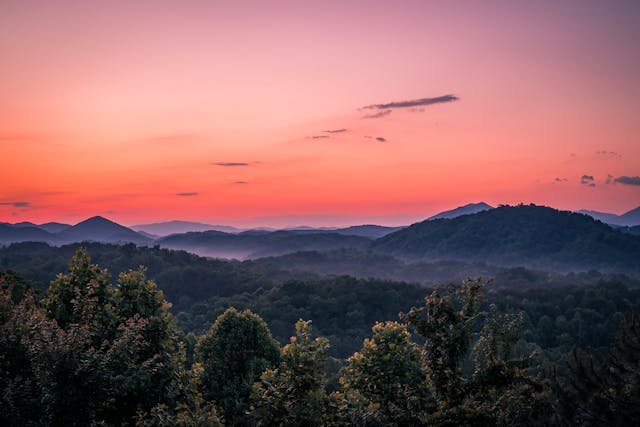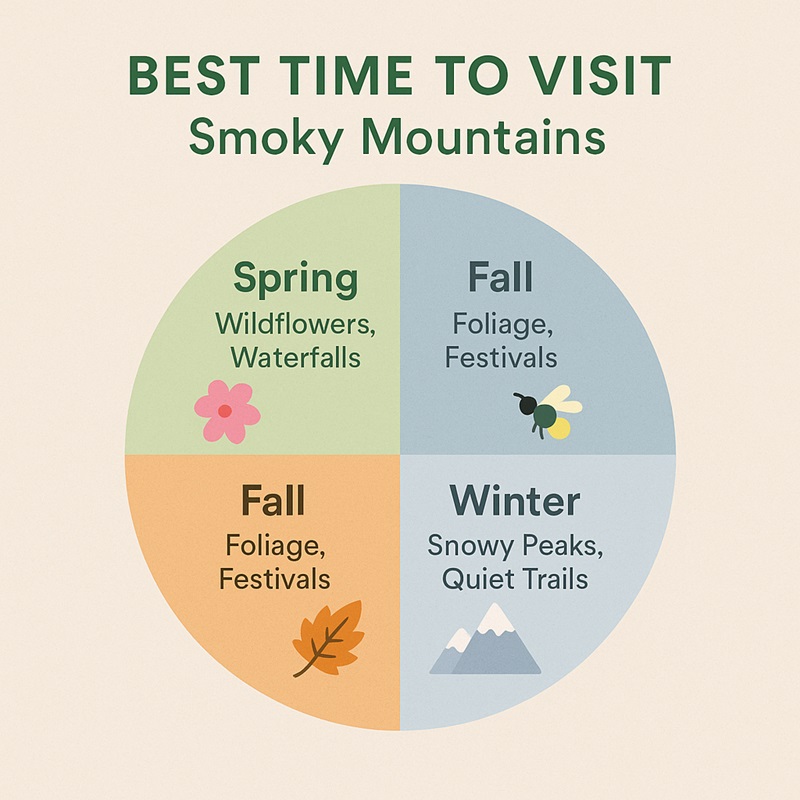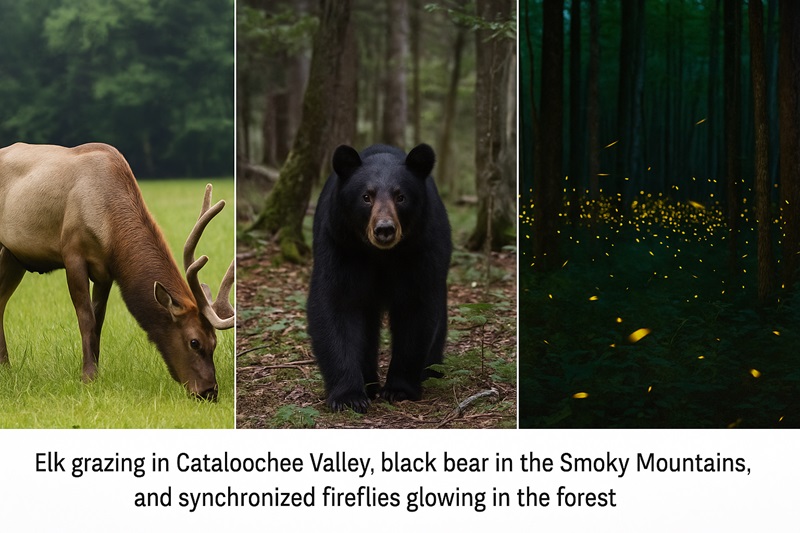Stretching across the border of Tennessee and North Carolina, the Great Smoky Mountains are the most visited national park in the United States, drawing over 12 million visitors each year. Known for their rolling mist, ancient mountains, and rich biodiversity, the Smokies are more than just a scenic escape—they’re a living museum of natural history and Appalachian culture.
But three big questions often come up for first-time visitors:
- Why is it called the Smoky Mountains?
- What are the best things to do once you get there?
- When is the best time to visit?
Here, you’ll find the history behind the name, the top things to do, and the best times to visit—all in one place.
Why Are They Called the “Smoky Mountains”?
Short answer:
They’re called the Smoky Mountains because a natural blue-gray haze often drifts over the ridgelines. Cherokee people long ago called the area Shaconage—“place of the blue smoke.” Scientifically, the “smoke” is plant-made haze: trees release VOCs that scatter light, creating the park’s signature misty look.
Cherokee Origins: “Place of the Blue Smoke”
For centuries, the Cherokee referred to this region as Shaconage, meaning “place of the blue smoke.” The soft veil over the valleys was seen as spiritual and protective—part of the land’s character, not just a weather quirk.
The Science Behind the Haze
The Smokies’ forests emit volatile organic compounds (VOCs). When VOCs mix with sunlight, moisture, and tiny airborne particles, they scatter blue wavelengths of light. The result is a bluish, smoke-like haze, especially noticeable on warm, humid days after rain.
Symbol, Brand, and Sense of Place
The haze gave the mountains their identity. Today, “Smoky” means Appalachian beauty. You see it on postcards, park signs, and at local festivals.
The mist is not a trick or machine-made fog. It is the forest breathing. Knowing this adds meaning to every overlook and photo.
Best Time to Visit the Smoky Mountains
The Smoky Mountains are open year-round, but the experience changes dramatically with the seasons. Deciding on the best time to visit the Smoky Mountains depends on what you want out of your trip.
Spring (March – May): Wildflower Wonderland
Spring is one of the most breathtaking times in the park. Over 1,500 species of flowering plants bloom here, giving the Smokies the nickname “Wildflower National Park.” Expect waterfalls rushing at full strength from snowmelt, mild hiking conditions, and fewer crowds compared to summer.
Summer (June – August): Peak Adventure Season
Families flock here in summer. The weather is warm but cooler at higher elevations, making it ideal for camping and hiking. Wildlife is active, and you may spot black bears, elk, or synchronous fireflies in June—a natural wonder that only happens in a few places worldwide. Be prepared, though: this is the busiest time of year.
Fall (September – November): Leaf-Peeping Paradise
Fall is arguably the most popular season. The mountains explode with color as maples, oaks, and hickories paint the ridges in fiery reds, oranges, and golds. Photographers and hikers alike treasure this time. Cooler weather makes outdoor activities even more enjoyable, though lodging books up quickly.
Winter (December – February): Quiet Beauty
For those who prefer solitude, winter offers snow-dusted peaks, frozen waterfalls, and cozy cabin stays. While some roads may close, scenic drives like Cades Cove often remain open. Winter is also the best time to snag off-season lodging rates.
What Is the Best Time to Visit the Smoky Mountains?
If you’re asking “what is the single best time to visit the Smoky Mountains?” most travelers agree on mid-October. This is when fall foliage reaches its vibrant peak, weather is crisp but comfortable, and the views are unmatched.
That said, the “best” time really depends on your priorities:
- For fewer crowds & blooming wildflowers: go in April or early May.
- For family trips & active wildlife: June is ideal.
- For dramatic fall colors: aim for mid- to late October.
- For peaceful, budget-friendly stays: visit in January or February.
By aligning your visit with the season that matches your interests, you’ll experience the Smokies at their absolute best.
Top 10 Things to Do in the Smoky Mountains
1. Hike to Clingmans Dome
Standing at 6,643 feet, Clingmans Dome is the highest point in the park and rewards visitors with sweeping, 360-degree views. The paved half-mile trail may test your legs, but at the summit you’ll feel as if you’re standing above the clouds—a moment worth every breath.
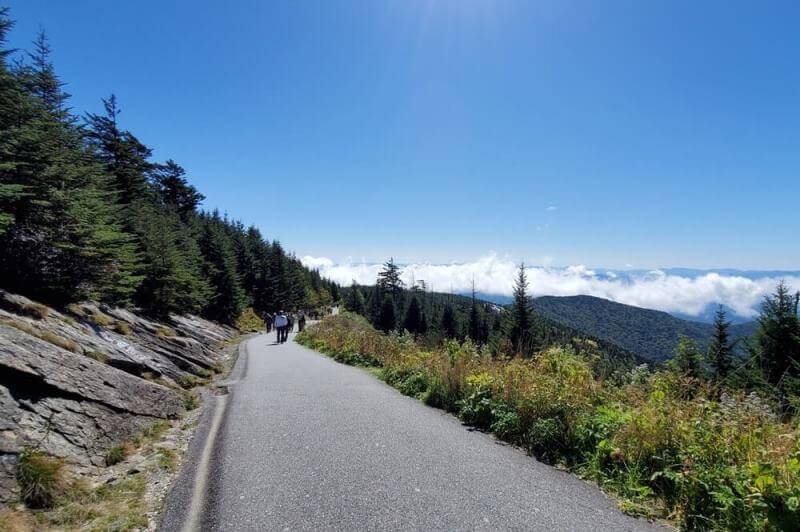
- Where to Start: Park at Clingmans Dome parking area off Newfound Gap Road.
- Preparation & Tips: Wear sturdy shoes; the half-mile paved path is steep but short. Bring a jacket—even in summer, it’s cooler at high elevations.
- Who It’s Best For: Families, casual hikers, photographers. Accessible for most with moderate effort.
- Time Required: 1–2 hours including the walk and time at the summit.
- Extra Idea: Visit at sunrise or sunset for magical cloud inversions and panoramic mountain silhouettes.
2. Explore Cades Cove
Cades Cove is a valley frozen in time. As you drive the 11-mile loop, you’ll pass rolling meadows, historic cabins, and likely spot deer grazing in the morning mist—or even a black bear lumbering across the road. Bring a picnic, take your time, and step into Appalachian history.
- Where to Start: Begin at Cades Cove Loop Road, near Townsend, TN.
- Preparation & Tips: Arrive early in the morning to avoid traffic and see more wildlife. Pack snacks or a picnic; there are picnic areas along the loop.
- Who It’s Best For: History buffs, wildlife enthusiasts, families. The loop is drivable with optional hikes.
- Time Required: 2–4 hours by car, longer if stopping frequently.
- Extra Idea: Rent a bike and ride the loop on Wednesdays and Saturdays (May–September) when it’s closed to vehicles.
3. Chase Waterfalls
The Smokies are waterfall country, with more than 100 named falls scattered throughout. Hike to Laurel Falls, one of the park’s most photographed spots, or venture to Abrams Falls, where powerful cascades thunder into a deep pool. Each waterfall feels like a secret oasis waiting to be found.
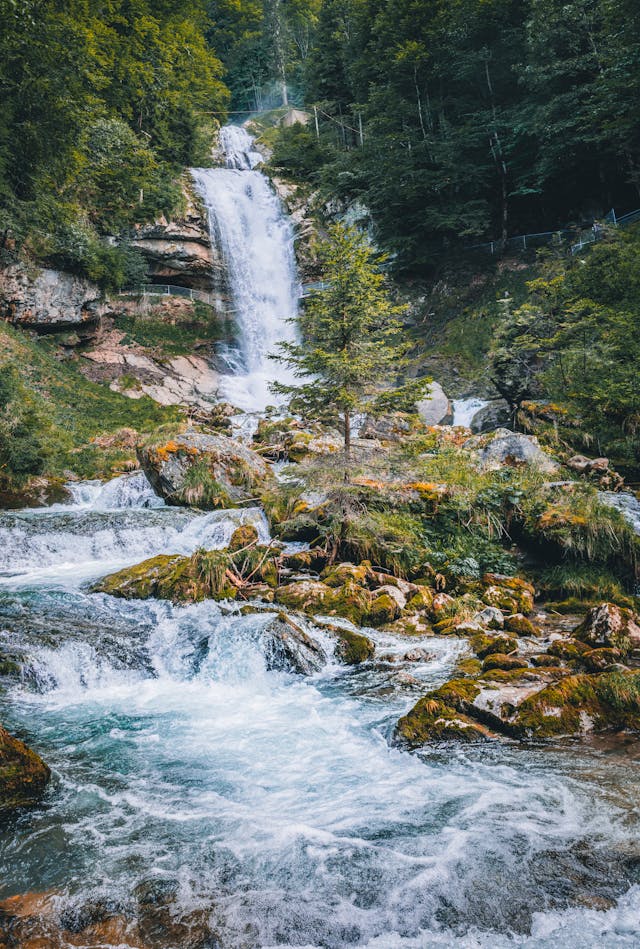
- Where to Start: Popular waterfalls include Laurel Falls (near Sugarlands Visitor Center) and Abrams Falls (in Cades Cove).
- Preparation & Tips: Trails can be slippery—bring hiking shoes and water. Abrams Falls is longer (5 miles round trip), Laurel Falls is shorter and paved.
- Who It’s Best For: Families (Laurel Falls), experienced hikers (Abrams Falls, Rainbow Falls).
- Time Required: 1–3 hours depending on the trail.
- Extra Idea: Try Grotto Falls, where you can walk behind the curtain of water—a rare and magical experience.
4. Drive the Newfound Gap Road
This 33-mile drive connects Gatlinburg, TN, to Cherokee, NC, and takes you through multiple ecosystems in just over an hour. Pull-offs reveal overlooks where the mountains seem endless, their blue haze softening every horizon. In fall, it’s a kaleidoscope of fiery reds and golds.
- Where to Start: Begin in Gatlinburg, TN, or Cherokee, NC. The road runs 33 miles through the heart of the park.
- Preparation & Tips: Plan for frequent stops at overlooks. In winter, check for weather closures.
- Who It’s Best For: All visitors—this is one of the easiest ways to see the park’s diversity.
- Time Required: 2–3 hours with stops.
- Extra Idea: Stop at Newfound Gap itself, where President Roosevelt dedicated the park in 1940.
5. Witness the Synchronous Fireflies
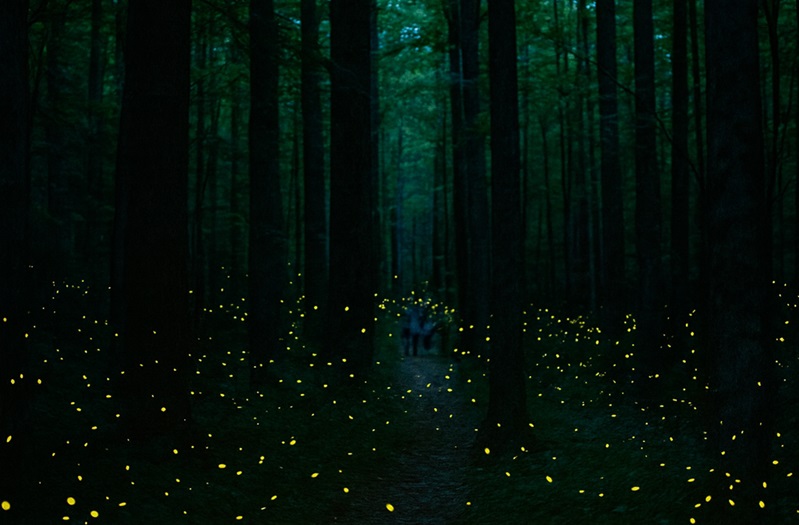
In early June, a natural light show transforms the forest. Thousands of fireflies blink in perfect harmony, lighting up the night in one of the world’s rarest phenomena. Viewing passes are limited and sell out quickly, making it one of the Smokies’ most magical experiences.
- Where to Start: Elkmont Campground is the primary viewing area. Tickets are distributed via lottery in May.
- Preparation & Tips: Bring a flashlight with red cellophane cover to avoid disturbing the fireflies. Pack bug spray and a folding chair.
- Who It’s Best For: Nature lovers, photographers, families with patience for late-night events.
- Time Required: 2–3 hours in the evening.
- Extra Idea: If you miss the ticket lottery, smaller displays can be seen in Cataloochee Valley and other darker spots in June.
6. Discover Appalachian History
Step into the past at the Mountain Farm Museum, where log homes, barns, and mills tell the story of early settlers. Or wander through old churches and pioneer cabins in Cades Cove, imagining life when survival depended on the land and community spirit.
- Where to Start: Visit the Mountain Farm Museum near Oconaluftee Visitor Center or explore historic buildings in Cades Cove.
- Preparation & Tips: Wear comfortable walking shoes; many sites involve short trails or uneven paths.
- Who It’s Best For: Families, history lovers, cultural travelers.
- Time Required: 1–2 hours at each site.
- Extra Idea: Attend ranger-led programs to hear stories about early settlers and the Cherokee.
7. Go Wildlife Watching
The Smokies are alive with creatures great and small. Elk roam Cataloochee Valley, black bears climb the ridges, and over 240 bird species fill the skies. Watching a mother bear and her cubs forage from a safe distance is a memory you’ll never forget.
- Where to Start: Cataloochee Valley (for elk), Cades Cove (for bears, deer, turkeys), and Clingmans Dome Road (for birds).
- Preparation & Tips: Bring binoculars, stay at least 50 yards from wildlife, and never feed animals. Best times are dawn and dusk.
- Who It’s Best For: Families, photographers, animal lovers.
- Time Required: Flexible—could be 1 hour or a whole day.
- Extra Idea: Visit in September–October to hear elk bugling, an unforgettable wildlife experience.
8. Take the Roaring Fork Motor Nature Trail
This quieter, 5.5-mile loop winds past streams, wildflowers, and preserved homesteads. Stop at trailheads for hikes like Grotto Falls, where you can actually walk behind the curtain of water. It’s less crowded than other areas and rich with character.
- Where to Start: Access from downtown Gatlinburg, TN.
- Preparation & Tips: The road is narrow—best for cars, not RVs. Download the self-guided tour booklet before your trip.
- Who It’s Best For: Visitors who want a mix of nature, waterfalls, and history without long hikes.
- Time Required: 1.5–2.5 hours with stops.
- Extra Idea: Hike to Grotto Falls (3 miles round trip) to walk behind the waterfall.
9. Experience Gatlinburg & Pigeon Forg
Beyond the park’s borders, adventure continues. Gatlinburg offers cozy cabins, local crafts, and the iconic SkyBridge, while Pigeon Forge delivers thrills at Dollywood, dinner theaters, and mountain coasters. It’s a lively contrast to the park’s serene wilderness.
- Where to Start: Gatlinburg is the gateway town to the park; Pigeon Forge is 15 minutes north.
- Preparation & Tips: Gatlinburg offers arts & crafts shops and the famous SkyBridge; Pigeon Forge has Dollywood, mountain coasters, and live shows. Expect crowds, especially in summer and fall.
- Who It’s Best For: Families, couples, travelers seeking a mix of nature and entertainment.
- Time Required: Half-day to multiple days depending on activities.
- Extra Idea: Visit the Great Smoky Arts & Crafts Community, an 8-mile loop showcasing local artisans.
10. Watch Sunrise or Sunset from an Overlook
End your trip with a moment of quiet awe. Sunrise at Newfound Gap or sunset from Morton Overlook paints the sky in pinks and purples, with mist rising from the valleys below. It’s a reminder that in the Smokies, nature always takes center stage.

- Where to Start: Morton Overlook (sunset) or Newfound Gap & Clingmans Dome (sunrise).
- Preparation & Tips: Bring a jacket—temperatures drop quickly in the mountains. Arrive 30 minutes early to get a good viewing spot.
- Who It’s Best For: Everyone—especially photographers, couples, and dreamers.
- Time Required: 1–2 hours including travel.
- Extra Idea: Pair sunrise or sunset with a picnic breakfast or dinner for a magical, memorable experience.
Before You Go: What to Know About the Smoky Mountains
Planning a trip to the Smoky Mountains is exciting, but a little preparation makes the difference between a good trip and an unforgettable one. Here are essential tips to help you get the most out of your visit.
Entrances & Access Points
- Gatlinburg, Tennessee: The most popular entrance, with easy access to Sugarlands Visitor Center, family-friendly trails, and nearby lodging. Perfect if you want a mix of town amenities and park exploration.
- Cherokee, North Carolina: Less crowded, with access to Oconaluftee Visitor Center and the Mountain Farm Museum. Great for cultural and historical immersion.
- Townsend, Tennessee: Known as the “Peaceful Side of the Smokies,” this entrance avoids the Gatlinburg crowds. Ideal for a quieter, more nature-focused trip.
- Cosby, Tennessee: Offers a backdoor entrance with great hiking opportunities, fewer tourists, and excellent campgrounds.
Lodging Options
- Cabins & Chalets: The most iconic Smoky Mountain experience—ranging from luxury lodges with hot tubs to rustic log cabins. Book well in advance for October (fall foliage) and summer.
- Campgrounds: The park offers frontcountry campgrounds like Elkmont, Smokemont, and Cades Cove, plus backcountry permits for backpackers. Reservations are required for most sites.
- Hotels & Inns: Gatlinburg and Pigeon Forge have everything from budget motels to upscale resorts, often with entertainment nearby.
- Pro Tip: Book lodging 6–12 months ahead for peak seasons (fall & summer) to avoid last-minute shortages.
Packing Essentials
- Layered Clothing: Weather can swing from hot valley afternoons to chilly mountain peaks—even in summer.
- Hiking Gear: Comfortable shoes/boots, a reusable water bottle, trail map or app, and trekking poles for longer hikes.
- Wildlife Safety Items: Bear spray (for backcountry hikes), binoculars, and food storage containers if camping.
- Rain Protection: Sudden showers are common, so bring a poncho or lightweight rain jacket.
- Extras: Flashlight, insect repellent, sunscreen (yes—even in the mountains), and snacks for the trail.
Park Fees & Regulations
- Entry Fee: Unlike most U.S. national parks, entrance to the Great Smoky Mountains National Park is free.
- Parking Tag Requirement: As of 2023, vehicles that stop for longer than 15 minutes need a parking tag.
- Daily Tag: $5
- Weekly Tag: $15
- Annual Tag: $40
Tags are available at visitor centers, kiosks, and online.
- Other Regulations: Dogs are only allowed on paved roads, picnic areas, and two trails (Gatlinburg Trail and Oconaluftee River Trail). Always follow Leave No Trace principles.
Best Visitor Centers
- Sugarlands Visitor Center (Gatlinburg, TN): Great for first-timers, trail info, maps, and wildlife exhibits.
- Oconaluftee Visitor Center (Cherokee, NC): Cultural exhibits and access to elk viewing areas.
- Cades Cove Visitor Center: Located in the middle of the Cades Cove loop, with historic buildings and a grist mill.
Connectivity & Safety
- Cell Service: Very limited inside the park—download maps offline before arriving.
- Emergency Tips: Carry a paper map, let someone know your hiking plan, and check trail closures online.
- Weather Warnings: Afternoon thunderstorms are common in summer; check forecasts and avoid high peaks during lightning risk.
FAQs About the Smoky Mountains
Why is it called the Smoky Mountains?
Because of the natural haze created by forest emissions interacting with sunlight and moisture, giving the mountains a smoky-blue appearance.
What is the best month to visit?
October for fall foliage, or April for wildflowers and fewer crowds.
What should I not miss when visiting?
Clingmans Dome, Cades Cove, Laurel Falls, and at least one sunrise or sunset overlook.
Are the Smoky Mountains dangerous?
Not inherently, but hikers should be cautious of sudden weather, bears, and steep terrain. Stick to marked trails and safety guidelines.
The Great Smoky Mountains are more than misty ridges on the horizon. They are a mix of history, culture, and wild beauty.
You can learn why they are called the Smoky Mountains, find the best times to visit, and enjoy countless things to do. Each season brings its own rewards.
Whether you come for a short hike, a family trip, or to sit at a quiet overlook, the Smokies always deliver one promise: lasting memories in nature’s masterpiece.


